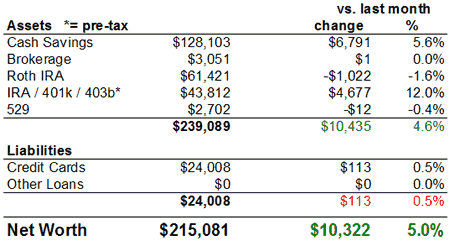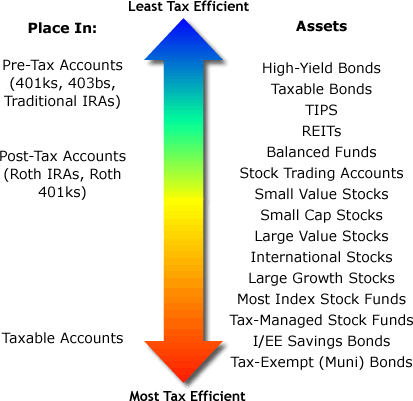Am I describing myself? Nah, just my selection of reading over this weekend:
Jeremy of GenXFinance offers a glimpse at his personal experiences while encouraging us not to make bad decisions during this volatile stock market.
My job has good and bad periods, and when the markets are up, everyone loves me and I hear nothing but good things. But at the same time, as soon as the markets begin to show some weakness, my phone is ringing constantly with worried investors. While you can occasionally talk some sense into certain people, others just go off and make irrational decisions.
Madame X of My Open Wallet has a series called New York Stories, which offers up real financial stories from real New Yorkers. I like it because these are kinds of stories you’d hear from your friends, if money wasn’t such a taboo topic. I particularly enjoyed the one by Escape Brooklyn.
Hazzard of Everybody Loves Your Money pointed me towards this post about the simple life. But if there’s one thing I’ve learned, it’s that simple does not equate to easy. For example, why is it we have to work hard and remember tips to keep things simple? Hmm?!
J.D. of Get Rich Slowly has a nice discussion going on about how to find work that you love. I tend to think that some people really do need to love their work, while others are able to keep a certain amount of detachment from it.
 It was in stock, then out of stock, now back in stock! Free Schick Quattro Titanium Razor sample, while supplies last. If successful, you should get the message “Thank you for signing up! Your free razor is on its way!”.
It was in stock, then out of stock, now back in stock! Free Schick Quattro Titanium Razor sample, while supplies last. If successful, you should get the message “Thank you for signing up! Your free razor is on its way!”. I don’t think REI makes this anymore, but it’s a pretty simple bag and cost about $125. It’s basically a big squarish backpack exactly the size limit of a carry-on, with nice padded shoulder straps and compression straps too. Good quality, YKK zippers. There is also a small detachable daypack – perfect for carrying your rain jacket, maps, guidebooks, and bottle of water when out and about. A similar bag would be
I don’t think REI makes this anymore, but it’s a pretty simple bag and cost about $125. It’s basically a big squarish backpack exactly the size limit of a carry-on, with nice padded shoulder straps and compression straps too. Good quality, YKK zippers. There is also a small detachable daypack – perfect for carrying your rain jacket, maps, guidebooks, and bottle of water when out and about. A similar bag would be  When deciding on your portfolio’s asset allocation, another option beyond broad stock funds in domestic or international markets is to invest in is real estate. Besides directly owning a home or office complex, an easy way to get exposure is to own Real Estate Investment Trusts, or REITs.
When deciding on your portfolio’s asset allocation, another option beyond broad stock funds in domestic or international markets is to invest in is real estate. Besides directly owning a home or office complex, an easy way to get exposure is to own Real Estate Investment Trusts, or REITs.  We’ve been slowly moving forward with the home-buying process, but I’ve fallen behind on the updates. We are far from experts and we might have done it all wrong, but here’s how we found our buyer’s agent to represent us. We started by essentially interviewing ourselves.
We’ve been slowly moving forward with the home-buying process, but I’ve fallen behind on the updates. We are far from experts and we might have done it all wrong, but here’s how we found our buyer’s agent to represent us. We started by essentially interviewing ourselves. Two, count ’em two, of my old hard drives died last week. And this web site went haywire (multiple times). I had the major files backed up, but my need for a better backup system became apparent. Ideally, it would be free, automated, and online. So what’s out there? Here are the best options I found:
Two, count ’em two, of my old hard drives died last week. And this web site went haywire (multiple times). I had the major files backed up, but my need for a better backup system became apparent. Ideally, it would be free, automated, and online. So what’s out there? Here are the best options I found:


 The Best Credit Card Bonus Offers – March 2024
The Best Credit Card Bonus Offers – March 2024 Big List of Free Stocks from Brokerage Apps
Big List of Free Stocks from Brokerage Apps Best Interest Rates on Cash - March 2024
Best Interest Rates on Cash - March 2024 Free Credit Scores x 3 + Free Credit Monitoring
Free Credit Scores x 3 + Free Credit Monitoring Best No Fee 0% APR Balance Transfer Offers
Best No Fee 0% APR Balance Transfer Offers Little-Known Cellular Data Plans That Can Save Big Money
Little-Known Cellular Data Plans That Can Save Big Money How To Haggle Your Cable or Direct TV Bill
How To Haggle Your Cable or Direct TV Bill Big List of Free Consumer Data Reports (Credit, Rent, Work)
Big List of Free Consumer Data Reports (Credit, Rent, Work)